Chapter 1: What Is Organizational Behavior pdf
Bạn đang xem bản rút gọn của tài liệu. Xem và tải ngay bản đầy đủ của tài liệu tại đây (7.65 MB, 172 trang )
PGSM- MBA Program 1
o r g a n i z a t i o n a l b e h a v i o ro r g a n i z a t i o n a l b e h a v i o r
stephen p. robbins
e l e v e n t h e d i t i o ne l e v e n t h e d i t i o n
ORGANIZATIONAL BEHAVIOR
S T E P H E N P. R O B B I N S
E L E V E N T H E D I T I O N
W W W . P R E N H A L L . C O M / R O B B I N S
© 2005 Prentice Hall Inc.
All rights reserved.
© 2005 Prentice Hall Inc.
All rights reserved.
PowerPoint Presentation
by Charlie Cook
PowerPoint Presentation
by Charlie Cook
What Is Organizational
Behavior
Chapter One
PGSM- MBA Program 2
© 2005 Prentice Hall Inc. All rights reserved. 1–2
After studying this chapter,
you should be able to:
1. Define organizational behavior (OB).
2. Describe what managers do.
3. Explain the value of the systematic study of
OB.
4. List the major challenges and opportunities for
managers to use OB concepts.
5. Identify the contributions made by major
behavioral science disciplines to OB.
L E A R N I N G O B J E C T I V E S
© 2005 Prentice Hall Inc. All rights reserved. 1–3
After studying this chapter,
you should be able to:
6. Describe why managers require a knowledge
of OB.
7. Explain the need for a contingency approach
to the study of OB.
8. Identify the three levels of analysis in this
book’s OB model.
L E A R N I N G O B J E C T I V E S (cont’d)
PGSM- MBA Program 3
© 2005 Prentice Hall Inc. All rights reserved. 1–4
What Managers DoWhat Managers Do
Managerial Activities
• Make decisions
• Allocate resources
• Direct activities of others
to attain goals
Managerial Activities
• Make decisions
• Allocate resources
• Direct activities of others
to attain goals
Managers (or administrators)
Individuals who achieve goals through other people.
© 2005 Prentice Hall Inc. All rights reserved. 1–5
Where Managers WorkWhere Managers Work
Organization
A consciously coordinated social unit,
composed of two or more people, that
functions on a relatively continuous basis
to achieve a common goal or set of
goals.
PGSM- MBA Program 4
© 2005 Prentice Hall Inc. All rights reserved. 1–6
Management FunctionsManagement Functions
Management
Functions
Management
Functions
PlanningPlanning
Organizing
Organizing
Leading
LeadingControllingControlling
© 2005 Prentice Hall Inc. All rights reserved. 1–7
Management Functions (cont’d)Management Functions (cont’d)
Planning
A process that includes defining goals,
establishing strategy, and developing
plans to coordinate activities.
PGSM- MBA Program 5
© 2005 Prentice Hall Inc. All rights reserved. 1–8
Management Functions (cont’d)Management Functions (cont’d)
Organizing
Determining what tasks are to be done,
who is to do them, how the tasks are to
be grouped, who reports to whom, and
where decisions are to be made.
© 2005 Prentice Hall Inc. All rights reserved. 1–9
Management Functions (cont’d)Management Functions (cont’d)
Leading
A function that includes motivating
employees, directing others, selecting
the most effective communication
channels, and resolving conflicts.
PGSM- MBA Program 6
© 2005 Prentice Hall Inc. All rights reserved. 1–10
Management Functions (cont’d)Management Functions (cont’d)
Controlling
Monitoring activities to ensure they are being
accomplished as planned and correcting any
significant deviations.
© 2005 Prentice Hall Inc. All rights reserved. 1–11
Mintzberg’s Managerial RolesMintzberg’s Managerial Roles
E X H I B I T 1–1
E X H I B I T 1–1
Source: Adapted from The Nature of Managerial Work by H. Mintzberg. Copyright © 1973
by H. Mintzberg. Reprinted by permission of Pearson Education.
PGSM- MBA Program 7
© 2005 Prentice Hall Inc. All rights reserved. 1–12
Mintzberg’s Managerial Roles (cont’d)Mintzberg’s Managerial Roles (cont’d)
E X H I B I T 1–1 (cont’d)
E X H I B I T 1–1 (cont’d)
Source: Adapted from The Nature of Managerial Work by H. Mintzberg. Copyright © 1973
by H. Mintzberg. Reprinted by permission of Pearson Education.
© 2005 Prentice Hall Inc. All rights reserved. 1–13
Mintzberg’s Managerial Roles (cont’d)Mintzberg’s Managerial Roles (cont’d)
E X H I B I T 1–1 (cont’d)
E X H I B I T 1–1 (cont’d)
Source: Adapted from The Nature of Managerial Work by H. Mintzberg. Copyright © 1973
by H. Mintzberg. Reprinted by permission of Pearson Education.
PGSM- MBA Program 8
© 2005 Prentice Hall Inc. All rights reserved. 1–14
Management SkillsManagement Skills
Technical skills
The ability to apply specialized
knowledge or expertise.
Human skills
The ability to work with, understand,
and motivate other people, both
individually and in groups.
Conceptual Skills
The mental ability to analyze and
diagnose complex situations.
© 2005 Prentice Hall Inc. All rights reserved. 1–15
Effective Versus Successful Managerial
Activities (Luthans)
Effective Versus Successful Managerial
Activities (Luthans)
1. Traditional management
• Decision making, planning, and controlling
2. Communication
• Exchanging routine information and processing
paperwork
3. Human resource management
• Motivating, disciplining, managing conflict, staffing,
and training
4. Networking
• Socializing, politicking, and interacting with others
1. Traditional management
• Decision making, planning, and controlling
2. Communication
• Exchanging routine information and processing
paperwork
3. Human resource management
• Motivating, disciplining, managing conflict, staffing,
and training
4. Networking
• Socializing, politicking, and interacting with others
PGSM- MBA Program 9
© 2005 Prentice Hall Inc. All rights reserved. 1–16
E X H I B I T 1–2
E X H I B I T 1–2
Allocation of Activities by TimeAllocation of Activities by Time
Source: Based on F. Luthans, R.M. Hodgetts, and S.A. Rosenkrantz,
Real Managers (Cambridge, MA: Ballinger, 1988).
© 2005 Prentice Hall Inc. All rights reserved. 1–17
Enter Organizational BehaviorEnter Organizational Behavior
Organizational behavior
(OB)
A field of study that
investigates the impact that
individuals, groups, and
structure have on behavior
within organizations, for the
purpose of applying such
knowledge toward improving
an organization’s effectiveness.
PGSM- MBA Program 10
© 2005 Prentice Hall Inc. All rights reserved. 1–18
Replacing Intuition with Systematic StudyReplacing Intuition with Systematic Study
Systematic study
Looking at relationships, attempting to attribute
causes and effects, and drawing conclusions based
on scientific evidence.
Provides a means to predict behaviors.
Intuition
A feeling not necessarily supported by research.
© 2005 Prentice Hall Inc. All rights reserved. 1–19
Replacing Intuition with Systematic StudyReplacing Intuition with Systematic Study
The
Facts
Preconceived
Notions
≠
PGSM- MBA Program 11
© 2005 Prentice Hall Inc. All rights reserved. 1–20
Toward an OB DisciplineToward an OB Discipline
E X H I B I T 1–3E X H I B I T 1–3
© 2005 Prentice Hall Inc. All rights reserved. 1–21
Contributing Disciplines to the OB FieldContributing Disciplines to the OB Field
E X H I B I T 1–3 (cont’d)
E X H I B I T 1–3 (cont’d)
Psychology
The science that seeks to measure, explain, and sometimes
change the behavior of humans and other animals.
PGSM- MBA Program 12
© 2005 Prentice Hall Inc. All rights reserved. 1–22
Contributing Disciplines to the OB Field (cont’d)Contributing Disciplines to the OB Field (cont’d)
E X H I B I T 1–3 (cont’d)
E X H I B I T 1–3 (cont’d)
Sociology
The study of people in relation to their fellow human beings.
© 2005 Prentice Hall Inc. All rights reserved. 1–23
Contributing Disciplines to the OB Field (cont’d)Contributing Disciplines to the OB Field (cont’d)
E X H I B I T 1–3 (cont’d)
E X H I B I T 1–3 (cont’d)
Social Psychology
An area within psychology that blends concepts from psychology
and sociology and that focuses on the influence of people on one
another.
PGSM- MBA Program 13
© 2005 Prentice Hall Inc. All rights reserved. 1–24
Contributing Disciplines to the OB Field (cont’d)Contributing Disciplines to the OB Field (cont’d)
E X H I B I T 1–3 (cont’d)
E X H I B I T 1–3 (cont’d)
Anthropology
The study of societies to learn about human beings and their
activities.
© 2005 Prentice Hall Inc. All rights reserved. 1–25
Contributing Disciplines to the OB Field (cont’d)Contributing Disciplines to the OB Field (cont’d)
E X H I B I T 1–3 (cont’d)
E X H I B I T 1–3 (cont’d)
Political Science
The study of the behavior of individuals and groups
within a political environment.
PGSM- MBA Program 14
© 2005 Prentice Hall Inc. All rights reserved. 1–26
E X H I B I T 1–4
E X H I B I T 1–4
Source: Drawing by Handelsman in
The New Yorker, Copyright © 1986
by the New Yorker Magazine.
Reprinted by permission.
© 2005 Prentice Hall Inc. All rights reserved. 1–27
There Are Few Absolutes in OBThere Are Few Absolutes in OB
Contingency
Variables
x y
Contingency variables
Situational factors: variables that moderate
the relationship between two or more other
variables and improve the correlation.
PGSM- MBA Program 15
© 2005 Prentice Hall Inc. All rights reserved. 1–28
Challenges and Opportunities for OBChallenges and Opportunities for OB
Responding to Globalization
– Increased foreign assignments
– Working with people from different cultures
– Coping with anti-capitalism backlash
– Overseeing movement of jobs to countries with low-
cost labor
Managing Workforce Diversity
– Embracing diversity
– Changing U.S. demographics
– Implications for managers
• Recognizing and responding to differences
© 2005 Prentice Hall Inc. All rights reserved. 1–29
Domestic
Partners
Domestic
Partners
Major Workforce Diversity CategoriesMajor Workforce Diversity Categories
RaceRace
Non-ChristianNon-Christian
National
Origin
National
Origin
AgeAge
DisabilityDisability
E X H I B I T 1–5
E X H I B I T 1–5
GenderGender
PGSM- MBA Program 16
© 2005 Prentice Hall Inc. All rights reserved. 1–30
Challenges and Opportunities for OB (cont’d)Challenges and Opportunities for OB (cont’d)
Improving Quality and Productivity
– Quality management (QM)
– Process reengineering
Responding to the Labor Shortage
– Changing work force demographics
– Fewer skilled laborers
– Early retirements and older workers
Improving Customer Service
– Increased expectation of service quality
– Customer-responsive cultures
© 2005 Prentice Hall Inc. All rights reserved. 1–31
What Is Quality Management?What Is Quality Management?
1. Intense focus on the customer.
2. Concern for continuous improvement.
3. Improvement in the quality of everything
the organization does.
4. Accurate measurement.
5. Empowerment of employees.
E X H I B I T 1–6
E X H I B I T 1–6
PGSM- MBA Program 17
© 2005 Prentice Hall Inc. All rights reserved. 1–32
Improving Quality and ProductivityImproving Quality and Productivity
Quality management (QM)
– The constant attainment of customer satisfaction
through the continuous improvement of all
organizational processes.
– Requires employees to rethink what they do and
become more involved in workplace decisions.
Process reengineering
– Asks managers to reconsider how work would be done
and their organization structured if they were starting
over.
– Instead of making incremental changes in processes,
reengineering involves evaluating every process in
terms of its contribution.
© 2005 Prentice Hall Inc. All rights reserved. 1–33
Challenges and Opportunity for OB (cont’d)Challenges and Opportunity for OB (cont’d)
Improving People Skills
Empowering People
Stimulating Innovation and Change
Coping with “Temporariness”
Working in Networked Organizations
Helping Employees Balance Work/Life Conflicts
Improving Ethical Behavior
PGSM- MBA Program 18
© 2005 Prentice Hall Inc. All rights reserved. 1–34
Basic OB Model, Stage IBasic OB Model, Stage I
E X H I B I T 1–7
E X H I B I T 1–7
Model
An abstraction of reality.
A simplified representation
of some real-world
phenomenon.
© 2005 Prentice Hall Inc. All rights reserved. 1–35
The Dependent VariablesThe Dependent Variables
x
y
Dependent variable
A response that is affected by an independent variable.
PGSM- MBA Program 19
© 2005 Prentice Hall Inc. All rights reserved. 1–36
The Dependent Variables (cont’d)The Dependent Variables (cont’d)
Productivity
A performance measure that includes
effectiveness and efficiency.
Effectiveness
Achievement of goals.
Efficiency
The ratio of effective
output to the input
required to achieve it.
© 2005 Prentice Hall Inc. All rights reserved. 1–37
The Dependent Variables (cont’d)The Dependent Variables (cont’d)
Absenteeism
The failure to report to work.
Turnover
The voluntary and
involuntary permanent
withdrawal from an
organization.
PGSM- MBA Program 20
© 2005 Prentice Hall Inc. All rights reserved. 1–38
The Dependent Variables (cont’d)The Dependent Variables (cont’d)
Organizational citizenship
behavior (OCB)
Discretionary behavior that is not
part of an employee’s formal job
requirements, but that nevertheless
promotes the effective functioning
of the organization.
© 2005 Prentice Hall Inc. All rights reserved. 1–39
The Dependent Variables (cont’d)The Dependent Variables (cont’d)
Job satisfaction
A general attitude toward one’s job, the difference
between the amount of reward workers receive and
the amount they believe they should receive.
PGSM- MBA Program 21
© 2005 Prentice Hall Inc. All rights reserved. 1–40
The Independent VariablesThe Independent Variables
Independent
Variables
Independent
Variables
Individual-Level
Variables
Individual-Level
Variables
Organization
System-Level
Variables
Organization
System-Level
Variables
Group-Level
Variables
Group-Level
Variables
Independent variable
The presumed cause of some change in the dependent
variable.
© 2005 Prentice Hall Inc. All rights reserved. 1–41
Basic OB
Model,
Stage II
Basic OB
Model,
Stage II
E X H I B I T 1–8E X H I B I T 1–8
PGSM- MBA Program 1
o r g a n i z a t i o n a l b e h a v i o ro r g a n i z a t i o n a l b e h a v i o r
stephen p. robbins
e l e v e n t h e d i t i o ne l e v e n t h e d i t i o n
ORGANIZATIONAL BEHAVIOR
S T E P H E N P. R O B B I N S
E L E V E N T H E D I T I O N
W W W . P R E N H A L L . C O M / R O B B I N S
© 2005 Prentice Hall Inc.
All rights reserved.
© 2005 Prentice Hall Inc.
All rights reserved.
PowerPoint Presentation
by Charlie Cook
PowerPoint Presentation
by Charlie Cook
Foundations of
Individual Behavior
Chapter 2
PGSM- MBA Program 2
© 2005 Prentice Hall Inc. All rights reserved. 2–2
After studying this chapter,
you should be able to:
1. Define the key biographical characteristics.
2. Identify two types of ability.
3. Shape the behavior of others.
4. Distinguish between the four schedules of
reinforcement.
5. Clarify the role of punishment in learning.
6. Practice self-management
L E A R N I N G O B J E C T I V E S
© 2005 Prentice Hall Inc. All rights reserved. 2–3
Biographical CharacteristicsBiographical Characteristics
Biographical Characteristics
Personal characteristics—such as age, gender,
and marital status—that are objective and
easily obtained from personnel records.
PGSM- MBA Program 3
© 2005 Prentice Hall Inc. All rights reserved. 2–4
Ability, Intellect, and IntelligenceAbility, Intellect, and Intelligence
Ability
An individual’s capacity to perform
the various tasks in a job.
Intellectual Ability
The capacity to do mental activities.
Multiple Intelligences
Intelligence contains four subparts:
cognitive, social, emotional, and cultural.
© 2005 Prentice Hall Inc. All rights reserved. 2–5
• Number aptitude
• Verbal comprehension
• Perceptual speed
• Inductive reasoning
• Deductive reasoning
• Spatial visualization
• Memory
• Number aptitude
• Verbal comprehension
• Perceptual speed
• Inductive reasoning
• Deductive reasoning
• Spatial visualization
• Memory
Dimensions of
Intellectual Ability
Dimensions of
Intellectual Ability
E X H I B I T 2–1
E X H I B I T 2–1
PGSM- MBA Program 4
© 2005 Prentice Hall Inc. All rights reserved. 2–6
Physical AbilitiesPhysical Abilities
Physical Abilities
The capacity to do tasks
demanding stamina, dexterity,
strength, and similar
characteristics.
© 2005 Prentice Hall Inc. All rights reserved. 2–7
Other Factors
7. Body coordination
8. Balance
9. Stamina
Other Factors
7. Body coordination
8. Balance
9. Stamina
Nine Physical AbilitiesNine Physical Abilities
Strength Factors
1. Dynamic strength
2. Trunk strength
3. Static strength
4. Explosive strength
Strength Factors
1. Dynamic strength
2. Trunk strength
3. Static strength
4. Explosive strength
Flexibility Factors
5. Extent flexibility
6. Dynamic flexibility
Flexibility Factors
5. Extent flexibility
6. Dynamic flexibility
E X H I B I T 2–2
E X H I B I T 2–2
Source: Adapted from
HRMagazine published
by the Society for Human
Resource Management,
Alexandria, VA.









